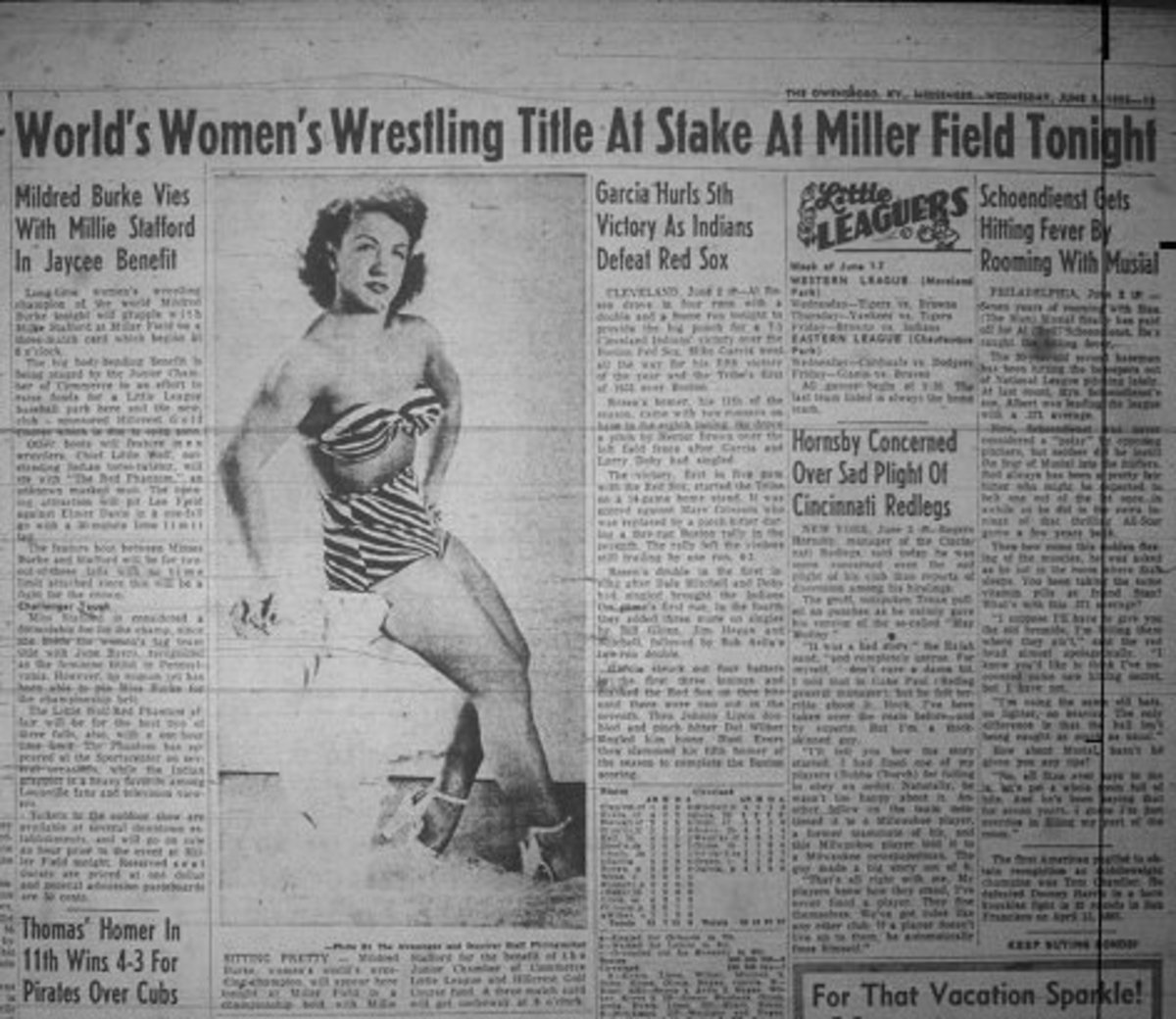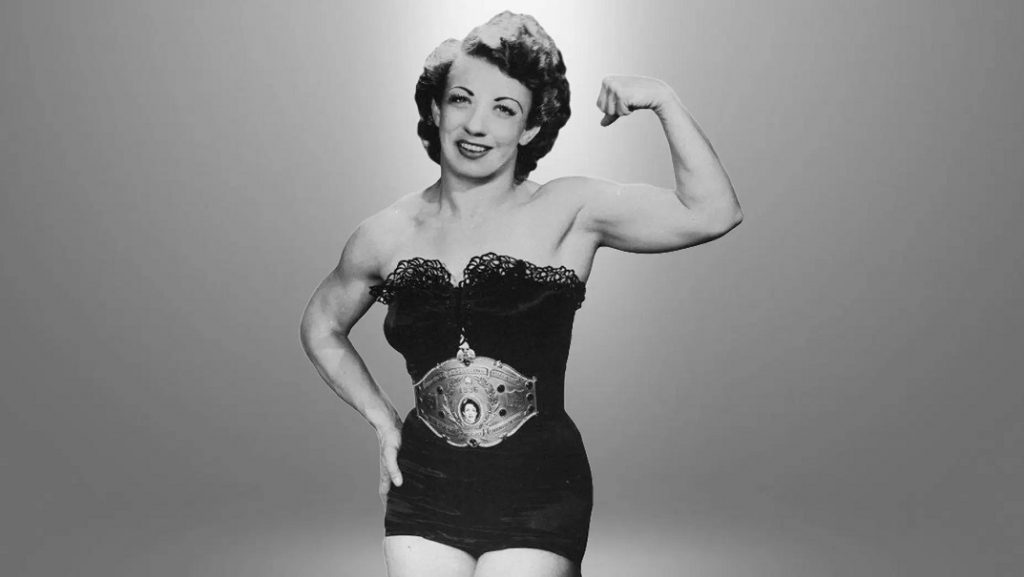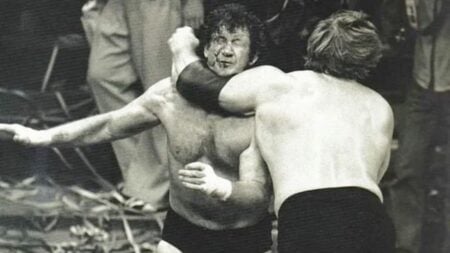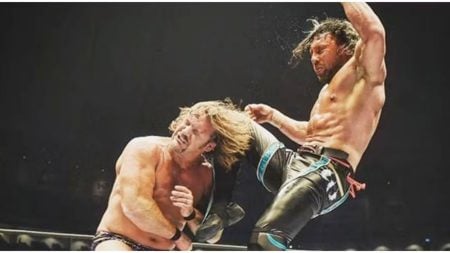Many of us have fond recollections of the Women’s Evolution of 2016. Divas became Superstars, and the WWE began to truly focus on top quality Women’s wrestling matches, many of which were given main-event status.
Gone were the days of lame and insulting gimmick-type confrontations. That move forward so long overdue. Mildred Burke, though, might categorize the events of 2016 as a mere drop in the bucket compared to the ground she broke decades earlier.
Burke blew barriers into smithereens in an era when the squared circle was the last place you would fathom seeing a woman perform. When the Woman’s Evolution took place in 2016, Hillary Clinton would lose her historic presidential bid to WWE.
When Mildred Burke was born in 1915, women weren’t even entitled to vote.
That essential right would come, in fact, in August of 1920 with the 19th Amendment. Burke, born Mildred Bliss, came into the world in abject poverty and at a time when the notions of growing up and being a wrestler, fighting versus men, and making a handsome living at it seemed absolutely preposterous.
That being said, society does evolve, and more often than not, it takes a rebellious visionary to shake and stir the martini of change. Mildred Burke was the perfect fit. She combined determination, drive, and natural talent and made women’s wrestling into a legitimate art form and top-notch attraction.

Mildred Burke – The Cult of Domesticity
Going back to the time of her birth, this feat becomes even more significant. At that time, American Society was still immersed in the cult of domesticity. Nothing to do with the Cult of Personality CM Punk had fun with on Raw.
The cult of domesticity in crude terms was akin to the Rock’s catchphrase, “Know your role and shut your mouth.”
Women were expected to live their lives around the following cornerstones: piety, purity, submission to males, and carrying out domestic tasks. Very few women worked, and those who did were primarily domestics, teachers, nurses, seamstresses, etc.
After the 1920 19th amendment, women did become more active in previously atypical ventures. This trend would also increase during the Great Depression when novel types of diversion gained greater acceptance. Athletics began to hold a place of interest.
Women in sports were a new concept and slowly began to gain acceptance. In a piece entitled “Sport in American History.” published on November 16th, 2017, Lindsay Pieper underscored the feats of some early sports heroines.
In 1926, Gertrude Ederle was toasted for being the first woman to swim the English Channel. She also became known for winning three medals in swimming at the 1924 London Olympiad.
In 1927, Ederle was feted with a huge ticker-tape parade in Manhattan. The attendance rivaled that of a similar event honoring Charles Lindbergh. Pieper observed in fact that Ederle’sachievement…
“helped define the 1920’s as the Golden Age of Sport.”
This was quite interesting when you realized to what extent Babe Ruth dominated the National pastime in 1927, shattering all kinds of records while becoming a national hero. Babe Didrickson Zaharias became the first multi-sport athlete to draw attention.
She captured medals in track and field events at the controversial and uneasy Berlin attempted “aryan infomercial” as laid out by Der Fuhrer.
Even Amelia Earhart captured the heart of the country when she became the first woman to fly solo across the Atlantic Ocean. All the aforementioned figures innovated and achieved immortality but did not shock and go against the grain as Mildred Burke did. The tide was turning in the right direction.
Nobody, though, anticipated the extent to which Mildred Burke would make it change by participating in wrestling. Combat sports and exhibitions involving women still seemed like they would be decades from ever happening.
The Times Though Were More Fertile To Change
As we entered the thirties, especially in the vast Mid-West, carnival and circus roadshows were all the rage. They toured the territories and constituted affordable family fun. These traveling shows were popular in the way movies were in pre-Covid times, yet I hardly think a bag of popcorn would sell for the exorbitant price of eleven dollars.
The year is 1932. Mildred Burke is a newlywed, and her husband is roughly twice her age. His name was Billy Wolfe, and he was a former wrestler with ties to the business.
While everything is up to date in Kansas City, this saying rang especially true for the carnival and roadshow forms of entertainment. It was at this time that Burke discovered and became infatuated with wrestling. Men’s bouts were top-line features and a young Mildred observed
“Watching those bouts had fascinated …and excited me in a way that I had never known before.”
The excitement led to motivation, obsession, and even visions of fame and fortune. Yes, the cult of domesticity had not disappeared, and it was a commonly held belief that women were not mentally tough enough to partake in combat sports or exhibitions. Mildred Burke would have no part of that. She, in fact, observed.
“If only I could become a lady wrestler, it would be such a novelty that people would crowd into the arenas to see me. The money would be in bundles, and I would be able to take care of my body.”
Burke was very persistent, and her efforts bore fruit, unexpected results that were far from the bottom of the branch. While Wolfe agreed to train his wife, his game plan was to make the venture into a “thanks for coming” affair.
He intended to get her ring-ready but was given every chance to fail against a male opponent that Wolfe had mentored as well. He anticipated a humiliating and painful defeat that would keep his wife miles away from the squared circle.
The exact opposite took place. Burke legitimately pinned her opponent twice in a minute, much to everyone’s astonishment except that of the victor. That led to a 180-degree turnaround, and Burke was to be trained as a legitimate fighter.
Necessity being the mother of invention, also played a role here. Burke and Wolfe were having a rough time financially, and her in-ring abilities were the proverbial last chance café card.
As previously seen, traveling carnivals were where the entertainment dollars were being spent in the Midwest. The next step up was arena shows, but the process was gradual and in no way set in stone. One could draw a parallel between rock bands doing club gigs versus arena shows.
We all know the greatest journeys begin with modest steps. Anybody who has ever ordered dinner #5 for two can certainly attest to that. The almond cookie versus fortune cookie debate will not be televised.
Men Would Pay To Challenge Mildred Burke
On the carnival circuit, burly, hard-working men would pay to challenge Burke to wrestling matches yet never make it to the pay window. None of these bouts were orchestrated at all. Notwithstanding her small stature, Burke relied on instinct and technique.
Just as color commentators will tell us today, the best way to neutralize a size differential is to keep your opponent on the mat. Burke used that modus operandi to her benefit. She did suffer one defeat, however, to a former collegiate wrestler who took out her knee with a well-placed kick. A patella can be so sensitive.
1935 is when Burke’s career really blossomed. She bid adieu to the carnival circuit and began performing in arena shows. Mildred never looked back. Cleared for takeoff and ready to soar.
Not only did her career garner success and attention, but Burke also made mainstream women’s wrestling an integral part of the art form. It was here to stay, all thanks to a clear and determined vision.
Over the next several years, Burke had an ongoing and fierce rivalry with Clara Mortenson. Burke and Mortenson had real-life heat akin to that of Joe Frazier and Muhammud Ali. Mortenson was blond and stood three inches taller than Burke.
She hailed from Sioux City, Iowa. The two would appear together across the country, and in the scripted outcomes, Mortenson would regularly emerge victoriously, which caused friction because Burke felt that she was legitimately superior.
Revenge Is A Dish Best Served In Front of 7100 People
Burke would extract some measure of revenge in 1937 when she cleanly defeated Mortenson before over 7100 fans in an arena show. Keep in mind that this was still very much in the throws of the Depression and four years prior to the United States entering the war.
While being prolific and successful, there were also big bumps in the road. Billy Wolfe delved deeper into training and booking women’s competitors and became intimate with several. Burke became aware of her husband’s galivanting and divorced him in 1952.
This made waves with the NWA, who first excluded women from their alliance meetings and then altogether banned women’s wrestling. Undaunted, Burke founded the WWWA. Let us read this excerpt from Howweplay.com.
Mildred Burke – ‘Promoting Women’s Wrestling
During the early 1950s, Mildred Burke was in Los Angeles and created the World Women’s Wrestling Association. During this time, she was considered to be a woman with a perfect physique. The Los Angeles Police Department would post pictures of Burke around the police station.
The goal was to inspire police officers who were out of shape to start working out in the gym. The NWA eventually started promoting women’s wrestling and claimed June Byers was their champion. Burke also maintained her title. She worked with Bill Newman to create the International Women’s Wrestler’s Inc.
The organization had offices in Sydney, Australia, New York City, and San Francisco. Burke also promoted women’s wrestling on an international basis. She created the World Wide Women’s Wrestling Association (WWWA). After retiring, Burke lived in California and operated a women’s wrestling school.”

Burke continued to book and promote women’s wrestling throughout her life until her passing in 1989. To refer to Burke as a visionary and a pioneer is a massive understatement.
She brought a “showy” element and dramatic appeal to women’s wrestling. Thanks to her skill and dedication, she ensured that it would be technically sound and more than credible looking.
Burke shattered barriers like a piledriver would lead to a soda cracker. Her contributions can only be further appreciated as that flat circle known as time marches on. Today’s talent will long flourish thanks to Burke’s commitment to being beyond legendary.







